
| Version | Summary | Created by | Modification | Content Size | Created at | Operation |
|---|---|---|---|---|---|---|
| 1 | Zuzana Hricoviniova | + 3525 word(s) | 3525 | 2021-08-18 06:22:33 | | | |
| 2 | Vivi Li | + 4 word(s) | 3529 | 2021-09-14 03:14:54 | | | | |
| 3 | Vivi Li | Meta information modification | 3529 | 2021-09-14 07:50:29 | | |
Video Upload Options
Nature has been a source of inspiration for the development of new pharmaceutically active agents. Polyphenols, including gallotannins, are widely studied as they protect cells against oxidative damage and pathogen attack. A series of new unnatural gallotannins (GTs), derived from D-lyxose, D-ribose, D-rhamnose, D-mannose, and D-fructose have been designed and synthesized i order to study the protective and antimicrobial effects of synthetic polyphenols that are structurally related to plant-derived products. Apart from spectral analysis, their antioxidant activity was evaluated. Structurally different GTs were screened in vitro for their antimicrobial properties against a spectrum of staphylococci, enterococci, and mycobacteria. Furthermore, the antibiofilm activity of GTs against S. aureus, and their ability to inhibit sortase A were inspected. Experimental data suggest that synthetic GTs could be considered as promising candidates for pharmacological, biomedical, and food industry applications.
1. Introduction
2. Results and Discussion on New Unnatural Gallotannins
2.1. Chemistry
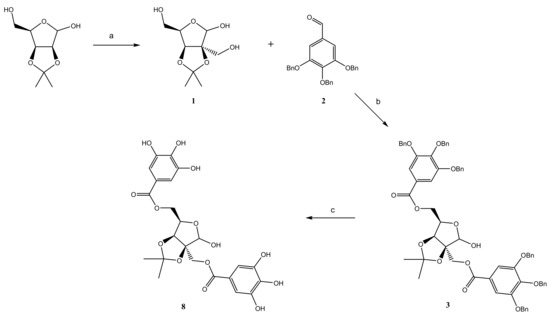
2.2. Antioxidant Activity
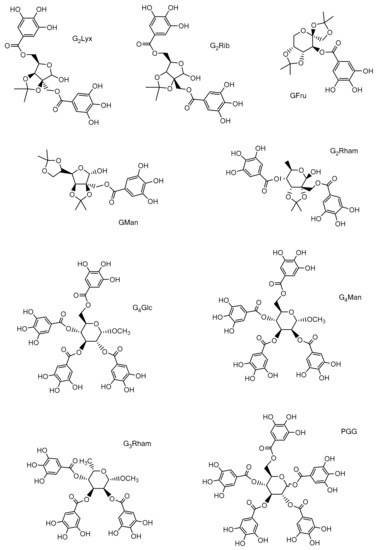
| Comp. | Concentration (mM) |
DPPH Scavenging Activity (%) | Reducing Power (Absorbance) |
|---|---|---|---|
| G2Lyx | 0.1 | 49.97 ± 1.14 | 0.675 ± 0.041 |
| 0.25 | 63.98 ± 1.05 | 0.886 ± 0.015 | |
| 0.5 | 75.35 ± 1.61 | 1.263 ± 0.053 | |
| 1 | 87.36 ± 1.35 | 1.699 ± 0.082 | |
| G2Rib | 0.1 | 52.67 ± 1.27 * | 0.698 ± 0.028 |
| 0.25 | 67.55 ± 1.08 * | 0.979 ± 0.015 | |
| 0.5 | 78.39 ± 1.11 | 1.185 ± 0.031 | |
| 1 | 87.95 ± 1.39 | 1.761 ± 0.102 | |
| G2Rham | 0.1 | 49.68 ± 2.13 | 0.622 ± 0.036 |
| 0.25 | 67.04 ± 1.72 | 0.904 ± 0.045 | |
| 0.5 | 79.63 ± 1.21 | 1.325 ± 0.018 | |
| 1 | 85.18 ± 1.03 | 1.711 ± 0.072 | |
| GMan | 0.1 | 33.57 ± 1.66 *** | 0.534 ± 0.081 * |
| 0.25 | 48.19 ± 2.09 ** | 0.871 ± 0.016 * | |
| 0.5 | 68.42 ± 1.74 * | 1.054 ± 0.037 * | |
| 1 | 71.28 ± 1.16 ** | 1.128 ± 0.057 ** | |
| GFru | 0.1 | 27.67± 1.25 *** | 0.485 ± 0.044 * |
| 0.25 | 39.29 ± 1.08 *** | 0.621 ± 0.073 ** | |
| 0.5 | 62.18 ± 1.13 *** | 0.823 ± 0.051 ** | |
| 1 | 73.36± 2.19 *** | 1.105 ± 0.069 ** | |
| G4Glc | 0.1 | 69.72 ± 1.59 *** | 0.826 ± 0.017 * |
| 0.25 | 75.35 ± 1.98 ** | 1.297 ± 0.044 ** | |
| 0.5 | 84.49 ± 2.27 * | 1.999 ± 0.081 ** | |
| 1 | 95.96 ± 1.77 ** | 2.267 ± 0.086 ** | |
| G4Man | 0.1 | 68.19 ± 1.54 *** | 0.779 ± 0.051 |
| 0.25 | 77.02 ± 2.11 ** | 1.307 ± 0.079 *** | |
| 0.5 | 83.76 ± 1.99 * | 1.878 ± 0.068 ** | |
| 1 | 95.01 ± 1.63 ** | 2.238 ± 0.039 ** | |
| G3Rham | 0.1 | 71.38 ± 1.74 *** | 0.801 ± 0.073 * |
| 0.25 | 78.14 ± 1.49 ** | 1.464 ± 0.057 ** | |
| 0.5 | 86.63 ± 2.08 * | 1.935 ± 0.108 *** | |
| 1 | 94.13 ± 1.27 ** | 2.197 ± 0.096 ** | |
| PGG | 0.1 | 75.32 ± 2.01 *** | 0.918 ± 0.025 * |
| 0.25 | 80.27 ± 1.14 *** | 1.506 ± 0.037 ** | |
| 0.5 | 92.35 ± 1.58 ** | 2.104 ± 0.093 *** | |
| 1 | 97.88 ± 1.22 ** | 2.307 ± 0.034 ** | |
| GA | 0.1 | 47.56 ± 1.45 | 0.688 ± 0.015 |
| 0.25 | 63.03 ± 2.06 | 1.002 ± 0.071 | |
| 0.5 | 76.89 ± 1.73 | 1.289 ± 0.059 | |
| 1 | 88.14 ± 1.16 | 1.736 ± 0.084 |
2.3. Antibacterial and Antimycobacterial Activity
| Comp. | MIC ([µg/mL]/[mM]) | ||||||||||
|---|---|---|---|---|---|---|---|---|---|---|---|
| SA | MRSA-1 | MRSA-2 | MRSA-3 | EF | VRE-1 | VRE-2 | VRE-3 | MT | MK | MS | |
| G4Glc | 256/ 318 |
256/ 318 |
64/ 79.7 |
64/ 79.7 |
32/ 39.8 |
64/ 79.7 |
256/ 318 |
256/ 318 |
>128/ >159 |
256 318 |
256/ 318 |
| G4Man | 64/ 79.7 |
256/ 318 |
64/ 79.7 |
64/ 79.7 |
16/ 19.9 |
32/ 39.8 |
256/ 318 |
256/ 318 |
>128/ >159 |
128/ 159 |
256/ 318 |
| G3Rham | 128/ 201 |
256/ 403 |
128/ 201 |
128/ 201 |
32/ 50.4 |
128/ 201 |
256/ 403 |
256/ 403 |
>128/ >201 |
128/ 201 |
256/ 403 |
| G2Lyx | >256/ >504 |
>256/ >504 |
>256/ >504 |
>256/ >504 |
>256/ >504 |
>256/ >504 |
>256/ >504 |
>256/ >504 |
>128/ >252 |
>256/ 504 |
>256/ 504 |
| G2Rham | 256/ 456 |
256/ 456 |
256/ 456 |
256/ 456 |
>256/ >456 |
>256/ >456 |
>256/ >456 |
>256/ >456 |
>256/ >456 |
>256/ >456 |
>256/ >456 |
| G2Rib | 128/ 244 |
256/ 488.2 |
256/ 488 |
128/ 244 |
>256/ >488 |
>256/ >488 |
>256/ >488 |
>256/ >488 |
>128/ >244 |
>256/ >488 |
>256/ >488 |
| GMan | 128/ 289 |
256/ 578 |
256/ 578 |
128/ 289 |
>256/ >578 |
>256/ >578 |
>256/ >578 |
>256/ >578 |
>128/ >289 |
>256/ >578 |
>256/ >578 |
| GFru | 128/ 310 |
128/ 310 |
256/ 620 |
128/ 310 |
>256/ >620 |
>256/ >620 |
>256/ >620 |
>256/ >620 |
>128/ >310 |
>256/ >620 |
>256/ >620 |
| PGG | 32/ 34.0 |
128/ 136 |
32/ 34.0 |
16/ 17.0 |
16/ 17.0 |
64/ 68.0 |
128/ 136 |
256/ 272 |
>128/ >136 |
256/ 272 |
>256/ >272 |
| GA | 256/ 1487 |
64/ 371 |
64/ 371 |
32/ 185 |
>256/ >1487 |
>256/ >1487 |
>256/ >1487 |
>256/ >1487 |
>128/ >743 |
256/ 1487 |
>256/ >1487 |
| AMP | 2/ 5.72 |
16/ 45.8 |
>16/ >45.8 |
>16/ >45.8 |
1/ 2.86 |
4/ 11.5 |
4/ 11.5 |
4/ 11.5 |
– | – | – |
| INH | – | – | – | – | – | – | – | – | 8 58.0 |
4 29.1 |
16 117 |
2.4. Antibiofilm Activity
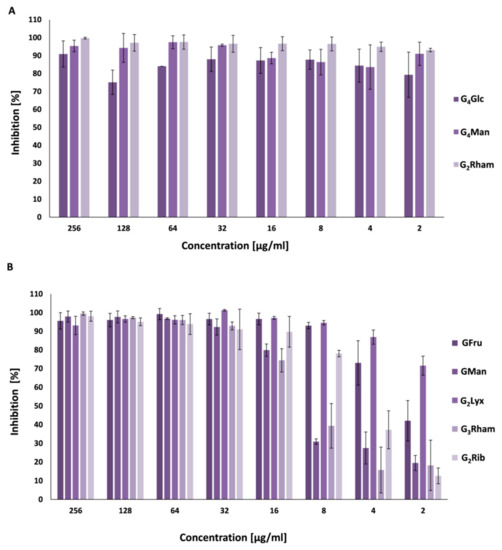
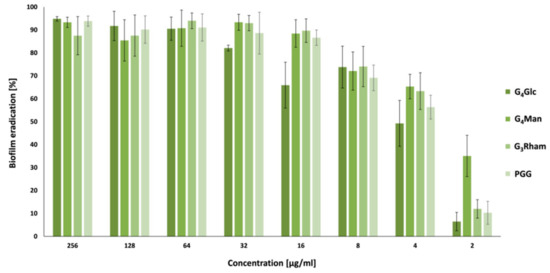
2.5. Quorum Sensing Inhibition
| Comp. (conc. 10 mg/mL) |
Diameter of Inhibition Zone on Agar [mm] |
|---|---|
| G4Glc | 5.00 ± 0.01 |
| G4Man | 8.50 ± 2.90 |
| G3Rham | 7.00 ± 1.40 |
| G2Rham | – |
| G2Rib | 8.30 ± 0.62 |
| G2Lyx | 5.00 ± 1.01 |
| GMan | 3.00 ± 0.02 |
| GFru | 6.50 ± 1.31 |
| PGG | 6.00 ± 0.01 |
2.6. Inhibition of Sortase A
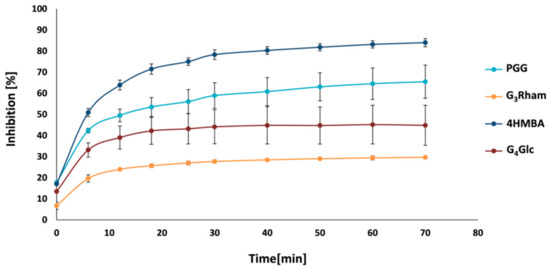
3. Future directions
References
- Khanbabaee, K.; van Ree, T. Tannins: classification and definition. Nat. Prod. Rep. 2001, 18, 641–649.
- Quideau, S.; Deffieux, D.; Douat-Casassus, C.; Pouysegu L. Plant Polyphenols: Chemical Properties, Biological Activities, and Synthesis. Angew. Chem. Int. Ed. 2011, 50, 586 – 621.
- Barbehenn, R.V.; Constabel, C.P. Tannins in plant–herbivore interactions. Phytochemistry. 2011, 72, 1551–1565.
- Chung, K.T.; Wong, T.Y.; Wei, C.I.; Huang, Y.W.; Lin, Y. Tannins and Human Health: A Review.Critical Reviews in Food Science and Nutrition1998, 38, 421–464.
- Kiss, A.K.; Piwowarski, J.P. Ellagitannins, gallotannins and their metabolites - The contribution to the Anti-Inflammatory effect of food products and medicinal plants.Curr. Med. Chem. 2018, 25, 4946–4967.
- Lee, S.J.; Lee, H.K.; Jung, M.K.; Mar, W. In vitro antiviral activity of 1,2,3,4,6-Penta-O-galloyl-b-D-glucose against hepatitis B virus. Biol. Pharm. Bull. 2006, 29, 2131–2134.
- Zhang, J.; Li, L.; Kim, S.H.; Hagerman, A.E.; Lü, J. Anti-Cancer, Anti-Diabetic and Other Pharmacologic and Biological Activities of Penta Galloyl-Glucose. Pharmaceut. Res. 2009, 26, 2066–2080.
- Yin, S.; Dong, Y.; Li, J.; Lü, J.; Hu, H. Penta-1,2,3,4,6-O-galloyl-β-D-glucose induces senescence-like terminal S-phase arrest in Human hepatoma and breast cancer cells. Mol. Carcinog. 2011, 50, 592–600.
- Jourdes, M.; Pouysegu, L.; Deffieux, D.; Teissedre, P.-L.; Quideau, S. Hydrolyzable tannins: gallotannins and ellagitannins. In: Ramawat K.G., Merillon J.M. (Eds.) Natural products: phytochemistry, botany and metabolism of alkaloids, phenolics and terpenes. Springer, Berlin, 2013, 1975–2010.
- Wu, Y.P.; Liu, X.Y.; Bai, J.R.; Xie, H.C.; Ye, S.L.; Zhong, K.; Huang, Y.N.; Gao, H. Inhibitory effect of a natural phenolic compound, 3-p-trans-coumaroyl-2-hydroxyquinic acid against the attachment phase of biofilm formation of Staphylococcus aureus through targeting sortase A. RSC Advances, 2019, 9, 32453–32461.
- Blando, F.; Russo, R.; Negro, C.; De Bellis, L.; Frassinetti, S. Antimicrobial and Antibiofilm Activity against Staphylococcus aureus of Opuntiaficus-indica (L.) Mill. Cladode Polyphenolic Extracts. Antioxidants, 2019, 8, 117.
- Gotz F. Staphylococcus and biofilms. Molec. Microbiol. 2002, 43, 1367–1378.
- Zheng, Y.; He, L.; Asiamah, T.K.; Otto, M. Colonization of medical devices by staphylococci. Environm. Microbiol. 2018, 20, 3141–3153.
- Takó, M.; Kerekes, E.B.; Zambrano, C.; Kotogán, A.; Papp, T.; Krisch, J.; Vágvölgyi, C. Plant Phenolics and Phenolic-Enriched Extracts as Antimicrobial Agents against Food Contaminating Microorganisms. Antioxidants, 2020, 9, 165.
- Amakura, Y.; Yoshimura, M.; Sugimoto, N.; Yamazaki, T.; Yoshida, T. Marker constituents of the natural antioxidant eucalyptus leaf extract for the evaluation of food additives. Biosci. Biotechnol. Biochem. 2009, 73, 1060–1065.
- Abou-Zaid, M.M.; Nozzolillo, C. 1-O-galloyl-α-l-rhamnose from Acer rubrum. Phytochemistry 1999, 52, 1629–1631.
- Xie, Y.; Zhao, Y. Synthesis of 7-O-galloyl-D-sedoheptulose. Carbohydr. Res. 2007, 342, 1510–1513.
- Ren, Y.; Himmeldirk, K.; Chen, X. Synthesis and structure-activity relationship study of antidiabetic penta-O-galloyl-D-glucopyranose and its analogues. J. Med. Chem. 2006, 49, 2829–2837.
- Cao, Y.; Himmeldirk, K.; Qian, Y.; Ren, Y.; Malki, A; Chen, X. Biological and biomedical functions of Penta-O-galloyl-D-glucose and its derivatives. J. Nat. Med. 2014, 68, 465–472.
- González-Sarrías, A.; Yuan, T.; Seeram, N.P. Cytotoxicity and structure activity relationship studies of maplexins A–I, gallotannins from red maple (Acer rubrum). Food Chem. Toxicol. 2012, 50, 1369–1376.
- Torres-León, C.; Ventura-Sobrevilla, J.; Serna-Cock, L.; Ascacio-Valdés, J.A.; Contreras-Esquivel, J.; Aguilar, C.N. Pentagalloylglucose (PGG): A valuable phenolic compound with functional properties. J. Funct. Foods 2017, 37, 176–189.
- Jiamboonsri, P; Pithayanukul, P.; Bavovada, R.; Chomnawang, M.T. The Inhibitory Potential of Thai Mango Seed Kernel Extract against Methicillin-Resistant Staphylococcus Aureus. Molecules 2011, 16, 6255–6270.
- Lin, M.H.; Chang, F.R.; Hua, M.Y.; Wu, Y.C.; Liu, S.T. Inhibitory Effects of 1,2,3,4,6-Penta-O-Galloyl-β-d-Glucopyranose on Biofilm Formation by Staphylococcus aureus. Antimicrob. Agents and Chemotherapy, 2011, 55, 1021–1027.
- Zhao, Y.; Wang, B.; Zhang, S.; Yang, S.; Wang, H.; Ren, A.; Yi, E. Isolation of antifungal compound from Paeoniasuffruticosa and its antifungal mechanism. Chinese J. Integrat. Med. 2014, 21, 211–216.
- Shafizadeh F. Branched-chain sugars of natural occurrence. Adv. Carbohydr. Chem. 1956, 48, 263–283.
- Grisebach, H.; Schmid, R. Chemistry and Biochemistry of Branched-Chain Sugars Angew. Chem. Internat. Edit. 1972, 1, 159–248.
- Beck, E.; Hopf, H. Branched-chain Sugars and Sugar Alcohols. Carbohydrates 1990, 235–289.
- Masaki, H.; Atsumi, T.; Sakurai, H. Hamamelitannin as a new potent active oxygen scavenger. Phytochemistry1994, 37, 337–343.
- Masaki, H.; Atsumi, T.; Sakurai, H. Peroxyl radical scavenging activities of hamamelitannin in chemical and biological systems. Free. Rad. Res. 1995, 22, 419–430.
- Lizárraga, D.; Touriño, S.; Reyes-Zurita, F.J.; de Kok, T.M.; van Delft, J.H.; Maas, L.M.; Briedé, J.J.; Centelles, J.J.; Torres, J.L.; Cascante, M. Witch hazel (Hamamelis virginiana) fractions and the importance of gallate moieties-electron transfer capacities in their antitumoral properties. J. Agric. Food. Chem.2008, 56, 11675–11682.
- Erdelmeier, C.; Cinatl, J.; Rabenau, H.; Doerr, H.; Biber, A.; Koch, E. Antiviral and Antiphlogistic Activities of Hamamelisvirginiana Bark. Planta Medica, 1996, 62, 241–245.
- Sánchez-Tena, S.; Fernández-Cachón, M.F.; Carreras, A.A.; Mateos-Martín, M.L.; Costoya, N.; Moyer, M.P.; Nuñez, M.J.; Torres, J.L. Cascante M. Hamamelitannin from Witch Hazel (Hamamelis virginiana) Displays Specific Cytotoxic Activity against Colon Cancer Cells. J. Nat. Prod. 2012, 75, 26–33.
- Vermote, A.; Brackman, G.; Risseeuw, M.D.P.; Cappoen, D.; Cos, P.; Coenye, T.; Van Calenbergh, S. Novel Potentiators for Vancomycin in the Treatment of Biofilm-Related MRSA Infections via a Mix and Match Approach. ACS Med. Chem. Lett. 2016, 8, 38–42.
- Brackman, G.; Breyne, K.; De Rycke, R.; Vermote, A.; Van Nieuwerburgh, F.; Meyer, E.; Van Calenbergh, S.; Coenye, T. The quorum sensing inhibitor hamamelitannin increases antibiotic susceptibility of Staphylococcus aureus bioflms by affecting peptidoglycan biosynthesis and eDNA release. Sci. Rep. 2016, 6, 20321.
- Hricovíniová, J.; Ševčovičová, A.; Hricovíniová, Z. Evaluation of the genotoxic, DNA-protective and antioxidant profile of synthetic alkyl gallates and gallotannins using in vitro assays. Toxicol in Vitro, 2020,65, 104789.
- Siquet, C.; Paiva-Martins, F.; Lima, J.L.F.C.; Reis, S.; Borges, F. Antioxidant profile of dihydroxy- and trihydroxyphenolic acids - A structure-activity relationship study. Free Rad. Res. 2006, 40, 433–442.
- Jing, P.; Zhao, S.J.; Jian, W.J.; Qian, B.J.; Dong, Y.; Pang, J. Quantitative studies on structure-DPPH• scavenging activity relationships of food phenolic acids. Molecules 2012, 17, 12910–12924.
- Chan, E.W.L.; Gray, A.I.; Igoli, J.O.; Lee, S.M.; Goh, J.K. Galloylatedflavonolrhamnosides from the leaves of Calliandra tergemina with antibacterial activity against methicillin-resistant Staphylococcus aureus (MRSA). Phytochemistry, 2014, 107, 148–154.
- Bag, A.; Bhattacharyya, S.K.; Chattopadhyay, R.R. Isolation and identification of a gallotannin 1,2,6-tri-O-galloyl-β-d-glucopyranose from hydroalcoholic extract of Terminalia chebulafruits effective against multidrug-resistant uropathogens. J. Appl. Microbiol. 2013, 115, 390–397.
- Aguilar-Galvez, A.; Noratto, G.; Chambi, F.; Debaste, F.; Campos, D. Potential of tara (Caesalpinia spinosa) gallotannins and hydrolysates as natural antibacterial compounds. Food Chem. 2014, 156, 301–304.
- Maisetta, G.; Batoni, G.; Caboni, P.; Esin, S.; Rinaldi, A.C.; Zucca, P. Tannin profile, antioxidant properties, and antimicrobial activity of extracts from two Mediterranean species of parasitic plant Cytinus. BMC Complement. Alternat. Med. 2019, 19.
- Bag, A.; Chattopadhyay R.R. Synergistic antibiofilm efficacy of a gallotannin 1,2,6-tri-O-galloyl-β-D-glucopyranose from Terminalia chebula fruit in combination with gentamicinand trimethoprim against multidrug resistant uropathogenic Escherichia coli biofilms. PLOS ONE, 2017, 12, e0178712.
- Ta, C.; Arnason, J. Mini Review of Phytochemicals and Plant Taxa with Activity as Microbial Biofilm and Quorum Sensing Inhibitors. Molecules, 2015, 21, 29.
- Narla, A.V.; Borenstein, D.B.; Wingreen, N.S. A biophysical limit for quorum sensing in biofilms. PNAS, 2021, 118, e2022818118.
- Wang, G.; Gao, Y.; Wang, H.; Niu, X.; Wang, J. Baicalin weakens Staphylococcus aureus pathogenicity by targeting sortase B. Front. Cell. Infect. Microbiol. 2018, 8, 418.
- Oh, I.; Yang, W.-Y.; Chung, S.-C.; Kim, T.-Y.; Oh, K.-B.; Shin, J. In vitro sortasea inhibitory and antimicrobial activity of flavonoids isolated from the roots of Sophora flavescens. Arch. Pharm. Res. 2011, 34, 217–222.
- Mu, D.; Xiang, H.; Dong, H.; Wang, D.; Wang, T. Isovitexin, a potential candidate inhibitor of sortase A of Staphylococcus aureus USA 300. J. Microbiol. Biotechnol. 2018, 28, 1426–1432.
- Wang, J.; Shi, Y.; Jing, S.; Dong, H.; Wang, D.; Wang, T. Astilbin inhibits the activity of Sortase A from Streptococcus mutans. Molecules, 2019, 24, 465.
- Dong, J.; Zhang, L.; Xu, N.; Zhou, S.; Song, Y.; Yang, Q.; Liu, Y.; Yang, Y.; Ai X. Rutin reduces the pathogenicity of Streptococcus agalactiae to tilapia by inhibiting the activity of sortase A. Aquaculture, 2021,530,735743.




